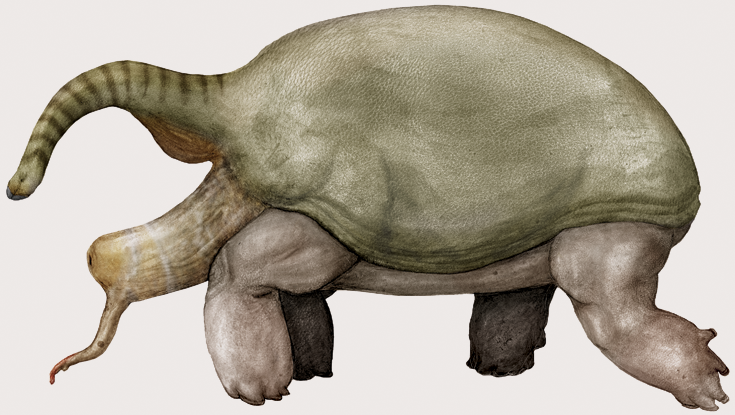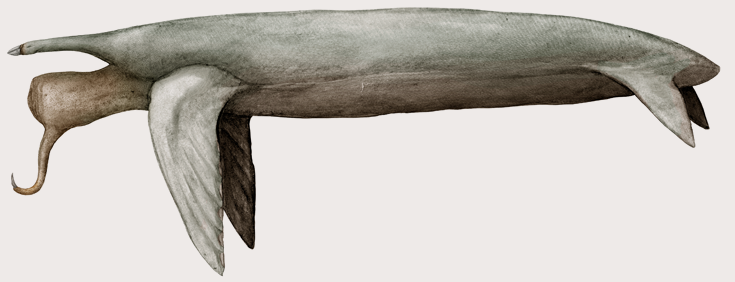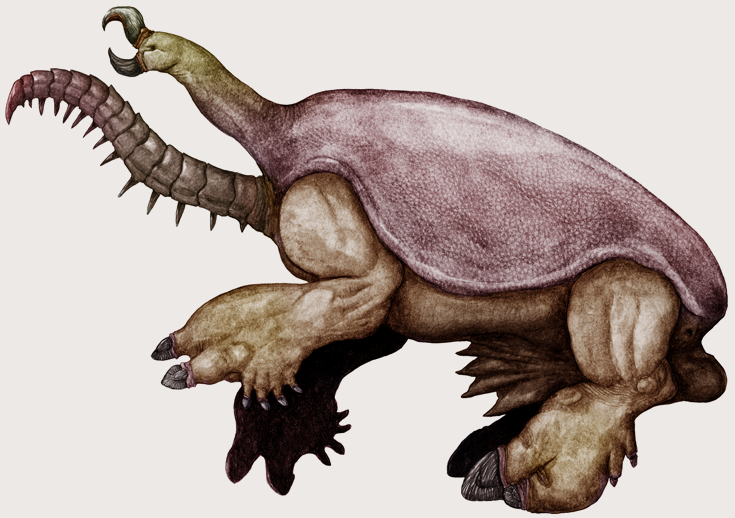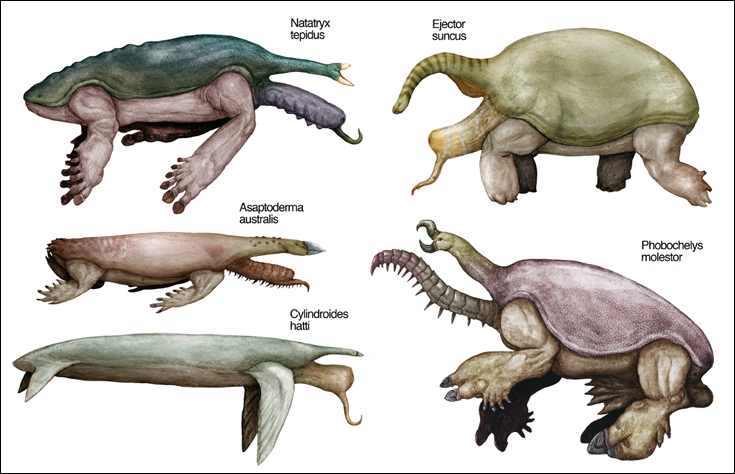Turtiformes
These are a group of unusual Polydactyls that are separated from all other such forms by the difference of their skeletons. Turtiformes are named so due to their superficial resemblance to Earth's turtles, but this is a faulty comparison in many ways. Turtiformes do have their bodies encased in a hard box of solid bones, but this structure lies beneath their dermal muscles and consequently no appendages except their second heads can be retracted into it. As a trade off, it leaves their limbs more free to move around. While most Turtiformes have a crawling limb posture, some forms have their legs tucked straight under their bodies and can be quite fast.
Turtiformes have evolved numerous forms, ranging from boring small omnivores to vicious predators, marine swimmers and freshwater grazers.

Species: Natatryx tepidus
Common Name: Green Slider.
Size: 30-35 centimeters.
Habitat: Rivers and ponds around north-eastern Isterna, introduced to the Great Dam.
This is a fairly typical Turtiform, an aquatic omnivore that browses in fresh water and sleeps on the land. Its feet have been elongated into paddle-like structures, although its unwebbed digits still give it a purchase on land. On its second head, Natatryx sports an accessory tentacle that is found in most members of the group. This organ is thought to have sensory as well as manipulative functions, and helps the animal to detect and grasp food items in the murky water. When handled, these animals release a sticky and extremely foul smelling liquid from their shrunken first heads.

Species: Ejector suncus
Common Names: Barfkettle, Kettleturt, Barfturtle.
Size: Up to 1 meter long.
Habitat: Pansavannah
Dotting the endless lush plains of Pansavannah like bright green melons, these conspicuous terrestrial Turtiformes are given a wide berth by most predators. These animals spend most of their lives calmly wandering around the plains while their disturbingly hyperactive second heads constantly pluck small animals and nutritious plants from the earth. Should they be attacked, they “vomit” an extremely potent irritant from their striped first heads with uncanny precision. This substance, actually a modified form of genital lubricant, is always aimed at the attackers’ eyes and has been observed blinding or even killing young and inexperienced predators.
With the equally toxic (but unrelated) Turtletanks (Hoploderma sp.) and poisonous Bandia Lophophids inhabiting the same region, Snaiadi zoologists have been paying special attention to the Pansavannah region, trying to figure out why so many slow but well-armed herbivores have been concentrated in this area. One popular theory is based on the historical presence of unknown, vicious predators in the region, but no fossil discoveries supporting this claim have emerged. The current assemblage of predators inhabiting Pansavannah is not much different from those elsewhere on the mainland continents.

Species: Asaptoderma australis
Common Name: No common name.
Size: Up to 25 centimeters long.
Habitat: Interior plains and rocky hills in Thalassia.
Asaptoderma represents a highly derived or highly basal (the debate rages on,) group of Turtiformes that have an extremely reduced bony shell and more flexibility in their bodies. What defense they need is instead provided by their speed and rear-pointing spines. Unlike their relatives, such Echinomochlid Turtiformes also show a marked tendency for a carnivorous diet. In the isolated evolutionary madhouse of Thalassia, these animals fill the niches occupied by the Tunicasaurian Whipsliders and other lizard-like groups on other continents.
This group is also known for its problematic distribution. Its relatives live on Aucaterra, Mapag and smaller Eastern ocean islands, but not on the mainland. Their fossils, however, are found in all of these places, including the mainland. At some point in the past, these animals must have accomplished a monumentally lucky feat of trans-oceanic rafting before dying out in the mainland, perhaps due to competition from more "normal" Turtiformes. The Echinomochlids’ historical place of origin, like their taxonomic affinity, is also the subject of a fervent debate.

Species: Cylindroides hatti
Common Name: Torpedo
Size: 4-5 meters long.
Habitat: Present in seas worldwide, but found mainly around the Three Seas around Midland.
The two species of Cylindroides and one related genus (Hydrolithos sp.) represent a unique radiation of marine Turtiformes uniquely suited to their environment. Cylindriform Turtiformes have turned the box-like inner shell of their relatives into a heavy, streamlined, hydrodynamic “hull” and have melded the six digits on each of their limbs into broad paddles. However, the most marked difference Cylindriformes have from other Turtiformes is in their reproduction systems. While other Turtiformes reproduce by laying eggs, these species have dispensed with terrestrial reproduction altogether and gestate their torpedo-shaped young inside their first-head neck like other live-bearing Snaiadi animals.
Not much else is known about these enigmatic swimmers due to their pelagic habits. More Cylindriform species might be discovered in the future.

Species: Phobochelys molestor
Common Name: Brute Turtle.
Size: 2 meters long, usually less.
Habitat: The island of Mapag.
The spectacular radiation of Turtiformes reached many islands, including the "lost world" of Mapag in the Aarite Ocean. There, the Turtiformes gave rise to their nastiest lineage: the aptly named Brute Turtles. In absence of other hunters, these clumsy creatures evolved into "garage-kit macropredators" that eerily recall the Fututors of the mainland. Instead of the swift killing grace and pelvic spikes of these unrelated predators, however, Brute Turtles sport barely vertical legs and a rasping, skid-like growth under their hips. Their second heads have also lost the sensory tentacle unique to their group, and sport a saw-like edge of sharp spikes that helps them tear and cut flesh. Finally, their first heads sport hook-like beaks that help them drag carcasses away into their lairs. Despite these impressive weapons, the Brute Turtles’ usual method of hunting involves jumping onto their prey and simply crushing them. Most of their quarry is made up of local Giant Armless Blumbomen, (Moai mapagalithops) but they also hunt smaller animals when possible.
Despite their vile habits and obvious risk to the public, these unusual animals are among the most popular zoo exhibits in the zoos of Snaiad.
Copyright laws protect all intellectual property associated with Snaiad.
All artwork, concepts and names associated with this project belong to C. M. Kosemen, unless otherwise stated.
